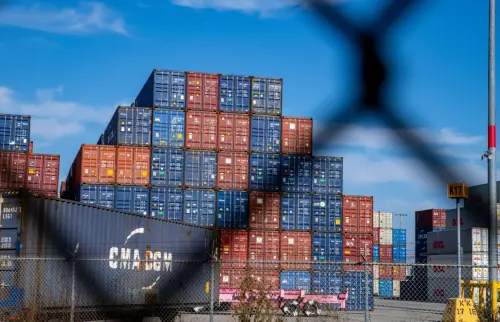The U.S. trade deficit has long been a source of political consternation, but it has come to the forefront in recent weeks. Just a few months into Donald Trump’s second term, he has made the trade deficit a key target of his aggressive tariff policies. On the day that President Trump announced a new, sweeping round of tariffs on all U.S. trade partners, Brookings Senior Fellow Gian Maria Milesi-Ferretti was joined by Maurice Obstfeld of the Peterson Institute for International Economics to discuss Obstfeld’s new paper, “The U.S. Trade Deficit: Myths and Realities.” On this episode of the Brookings Podcast on Economic Activity, Miles-Ferretti and Obstfeld explore the causes and consequences of the U.S. trade deficit, the role of China and other foreign nations, and broader implications for the American economy.
- Listen to the Brookings Podcast on Economic Activity on Apple, Spotify, YouTube, or wherever you like to get podcasts.
- Learn about other Brookings podcasts from the Brookings Podcast Network.
- Sign up for the podcasts newsletter for occasional updates on featured episodes and new shows.
- Send feedback email to [email protected].
Transcript
[music]
EBERLY: I’m Jan Eberly, the James R. and Helen D. Russell Professor of Finance at Northwestern University.
STEINSSON: And I’m Jón Steinsson, Chancellor’s Professor of Economics at the University of California, Berkeley.
EBERLY: And we’re the co-editors of the Brookings Papers on Economic Activity, a semi-annual academic conference and journal that pairs rigorous research with real-time policy analysis to address the most urgent economic challenges of the day.
STEINSSON: And this is the Brookings Podcast on Economic Activity, where we share conversations with leading experts on the research they do and how it will affect economic policy.
EBERLY: Thanks for downloading the first episode of season six of the BPEA podcast. This season, we’ll be listening to discussions about papers from the Spring 2025 BPEA conference hosted by Brookings on March 27th and 28th.
STEINSSON: A number of the topics to be discussed this season are particularly timely. These include China’s economic growth, the U.S. trade deficit, and housing affordability.
EBERLY: Plus, we have new papers on the recovery from the COVID-19 recession, labor migration, and the role of the Federal Reserve in preventing treasury market dysfunction. As always, we’re covering a wide range of topics.
We’re kicking this season off with two veterans of the BPEA podcast: Brookings Senior Fellow Gian Maria Milesi-Ferretti and Maury Obstfeld of the Peterson Institute for International Economics. who both joined our show back in season one to discuss Obstfeld’s work on the global dollar cycle. Today they’ll be discussing Obstfeld’s new paper, “The U.S. Trade Deficit: Myths and Realities.”
STEINSSON: Jan, this paper seems to be questioning the conventional wisdom about the underlying forces giving rise to the U.S. trade deficit over the past few decades.
EBERLY: That’s right! Much of the discussion in the media focuses on the conditions of trade, say competition from other countries or an abundance of global savings eager to purchase U.S. assets. But this paper brings the story home to the U.S.
Maury argues that U.S. borrows so much from the rest of the world to finance our budget deficit that it’s inevitable that we run a trade deficit. These two deficits both reflect the fact that we consume more now than our current income can support.
This perspective has important policy implications, since in order to restore balance, it says that the U.S. needs to address internal issues, like bringing revenue and spending into balance, rather than pushing other countries to reduce their trade with the U.S., say by tariffs or other trade restrictions.
STEINSSON: Right, it seems Maury is, to some extent, arguing for a quote-unquote “twin-deficits” explanation, a budget deficit and a trade deficit that go together, similar to what was widely discussed in the 1980s during the Reagan administration. I’m really looking forward to listening to the conversation.
Let’s turn it over to Gian Maria.
MILESI-FERRETTI: Thank you, Jan and Jón, and welcome, Maury. Nice to have you back on Brookings podcast.
[3:24]
OBSTFELD: Great to be here, Gian Maria.
MILESI-FERRETTI: So, I think this paper is as topical as it can be. On the day we are recording this podcast, April 2, we are expecting an announcement of new tariffs imposed by the United States on its trading partners.
It is clear from the rhetoric that accompanies these measures that the U.S. trade deficit and the U.S. debtor positions in the view of the administration primarily reflect actions that are taken by partner countries, which are, in some way, taking advantage of the United States. And we have seen just in the past week new data releases from the U.S. Bureau of Economic Analysis, which shows that the U.S. had a current account deficit vis-à-vis the rest of the world of close to 4% of U.S. GDP, so we’re talking of something in the range of $1 trillion plus and a net debtor position, which has now reached about 90% U.S. GDP.
So, Maury, I wanted to start maybe by asking you what you think the administration actions taken so far, as well as the actions we expect to be taken today, could entail for the U.S. economy and how they will deal with the numbers that I have just highlighted.
[5:12]
OBSTFELD: Well, two months into the Trump administration, we’ve seen a number of tariff announcements, some of which have been quickly withdrawn, then reinstated. It’s almost too dizzying to go through all of them, but the ones that seem to have stuck are steel and aluminum tariffs, highest tariffs on China, tariffs on autos. And today, which the administration calls Liberation Day, will presumably involve a much more far-reaching announcement. But again, with this administration, one never knows what to expect.
And one factor of the recent experience has been the enormous uncertainty over tariff and trade policy that has been unleashed really since the November election. The news-based measures of trade policy uncertainty that are tracked by several researchers have spiked up to unprecedented levels and research indicates that such uncertainty has a dampening effect on economic activity, particularly on investment. So, we’ll see what happens.
MILESI-FERRETTI: So, Maury, thank you very much for this. Can you guide us through your thinking on the diagnosis of the problem that we have that is underpinning really the administration’s actions? I know you’ve discussed these issues in the paper. It would be great to illuminate our listeners on this specific issue.
[6:50]
OBSTFELD: There are two fundamental variables that the administration focuses on, and particularly the president and his discourse. One is the trade deficit, which probably features more prominently. The president views a trade deficit as evidence that the United States is losing from trade when it imports more than it exports.
The other related issue is the level of manufacturing employment. Of course, manufacturing employment in the U.S. has dropped precipitously since its heyday in the early post-war period. Certainly, manufacturing employment as a percent of GDP has dropped slowly since the global financial crisis, but it continues to decline. This fall is reflected in the hollowing out of industry in the Rust Belt states and elsewhere in the U.S. These are states that are electorally very important.
And President Trump and his allies maintain that the primary cause of this hollowing out is international trade, which has led to the loss in U.S. jobs and also a loss in U.S. assets. You cited the recent figures on U.S. net international investment position, negative 90% of GDP, and that in part reflects losses incurred through ongoing trade deficits with the rest of the world.
The administration believes that the tariffs that are going to be rolled out and that have been rolled out can correct both of these problems, both return the U.S. trade balance to balance and reverse the decline in manufacturing employment and bring a big increase in factories and manufacturing jobs.
MILESI-FERRETTI: And is your sense that the diagnosis of the problem is correct? So, do you see the U.S. trade deficit as something that is really a reflection of foreigners in some way taking advantage of the U.S. and hollowing out its manufacturing structure?
[9:12]
OBSTFELD: I think the fundamental answer is “no,” that the decline in manufacturing bears some relation to trade issues, to the evolving nature of the global economy and the broader scheme of things. Around the year 1990, we had China entering the world economy in a big way, India reforming, the collapse of the Soviet bloc, and those countries entering the world economy.
So, we certainly had a rise in the global supply of labor, which I think has played some role in making lower price goods available to the U.S. and depressing global wages. So this is certainly something that is real. But the fundamental driver of declining manufacturing employment, which we see around the world in surplus countries and in deficit countries, has been rising productivity and manufacturing, which accompanies rising incomes and rising demands for the goods that are produced in the service sector.
So, to some level, declining manufacturing employment is an inevitable consequence of the structural transformation brought by higher productivity growth in tradable goods. The idea that the trade deficit is a function of foreign victimization of the U.S. I think is way off the mark.
There are a number of theories of why this might be true. One is that U.S. trade liberalization and foreign trade practices have added to a U.S. deficit. Another is that a global glut in saving driven in part by foreign countries’ suppression of consumption among their populations has created capital flows into the U.S. that require as a counterpart more U.S. consumption and more U.S. imports. And a final theory is that the specific role of the dollar as an international currency, and notably as an international reserve currency, requires the U.S. to run current account deficits to supply the world with dollars.
And I would argue that all three of these views are at best partial and at worst completely incorrect. But, fundamentally, the U.S. trade deficit is a macroeconomic phenomenon. It reflects the fact that the U.S. spends more than it produces. It is true that the rest of the world therefore spends less than it produces, but that doesn’t establish that the world’s actions are in some way forcing the U.S. to spend more than it produces. And that’s the sense in which the critics of trade complain that the U.S. is a victim, the U.S. is being forced to spend more than it produces. And I think that conclusion is very hard to support.
MILESI-FERRETTI: Thank you very much, Maury. And yes, I think some of the problems, the large figure on the U.S. debtor position, that negative net international investment position, which means basically the net claims that other countries have on the United States, the size of that position is very large, but it does depend also on the value that assets located in the United states have.
We all know how the value of U.S. stocks has skyrocketed in the past decade and a half, and that contributes to U.S. wealth, but since some of these stocks are owned by foreign investors, it does increase net U.S. liabilities vis-à-vis the rest of the world. So, what do you think would be needed to address problems related to U.S. external accounts? So is the trade deficit, is the current account deficit a problem? Is the big debtor position a problem. How can the United States implement policies that would help mitigate those problems?
[13:31]
OBSTFELD: Well, as you pointed out, it has to interpret the U.S. debtor position with caution because it’s only one component of U.S. wealth. And to take an example, as you pointed out last year, the U.S. current account deficit was 3.9% GDP. So if that were the only driver of the U.S. international position, the U.S. international position would have deteriorated by 3.90 percentage points of GDP. In fact, it deteriorated by almost 20 percentage points of GDP. And the primary reason was that the U.S. stock market did so well relative to foreign stock markets, which increases U.S. wealth. So in the broad picture of U.S. wealth, U.S. wealth owners did well. Another factor was the dollar’s appreciation, which improves the U.S. terms of trade and also benefits American consumers.
So, we have to be careful in looking at the net international investment position and concluding that the U.S. is so incredibly indebted that it can never dig its way out of that hole. That is only one portion of U.S. wealth, which includes the U.S.’s very productive capital stock, some of which is publicly traded and is a more important component of U.S. wealth.
Now, I worry more about another deficit, which is the U.S. federal deficit. And that’s intimately linked to the current account deficit because it’s a big part of the reason, not the only part, but a big of the part of reason why the U.S. saves so little and therefore borrows abroad.
Last year, the U.S. federal deficit was 6.5% of GDP. If U.S. saving cannot fully provide those funds to the U.S. government, it has to borrow abroad. And that’s where the connection comes in with the deficit.
There are legitimate worries, particularly with Congress preparing to take actions which will increase the deficit, that international lenders may be reaching a point where it may be harder to borrow abroad in terms of the world demanding higher interest rates. That’s a big problem for the fiscal position of the U.S. The U.S. government could address that problem, while also improving its trade balance, giving some more support to manufacturing by taking actions that bring down the government deficit. Those would involve, if they were to be durable, significant rethinking about entitlement programs and how to fund those longer term, not just chainsaw cuts to government spending that don’t amount to much, and also serious thinking about revenue sources, not just the administration’s current idea of going back to the tariff-based revenue system of the McKinley era.
MILESI-FERRETTI: Thanks, Maury. And indeed, what you say about the fiscal deficit ties in with the evolution of the external, the net international investment position, as well. We mentioned the good side of increasing equity prices, if you want the good reasons for the increase in U.S. liabilities. But you also have close to 50% of U.S. GDP worth in net debt, in debt instruments as opposed to equity, where the argument that high valuations reflect the strength of the U.S. economy is, of course, more questionable than is the case for equity.
So, I wanted to turn to lessons from history, really. These are not new debates, the size of the U.S. current account deficit, the dynamics of U.S. external liabilities. A lot of these themes were at the center of policy discussions even before the global financial crisis. And your paper does a masterful job of discussing those issues and putting history at work to evaluate the various theories that have been put out to explain what has happened.
So, can you guide us a bit through that? So how did we get where we are in terms of U.S. deficit and external positions, and what is your view on the extent to which these developments are driven by U.S. specific factors versus the behavior or, if you want, the underlying macro evolution in trading partners?
[18:22]
OBSTFELD: Well, the really long history, at least the long post-war history, is that the U.S. entered the post-war era with trade surplus and that has declined over time. The U.S. trade balance has been negative since sometime in the 1970s. In fact, the weakness of the trade balance was one of the factors in President Nixon leaving the Bretton Woods gold arrangements and trying to devalue the dollar in 1971.
Where you really see a sharp change, I think, or a sharp move toward deficit, toward the protracted deficits that we’ve had, the uninterrupted deficits, is in the Reagan era. If you look from, say, 1960 to 1980, the U.S. rate of personal saving was about 10%. Around 1980, it’s been closer to 5%. So that’s a big structural change in the behavior of households. Now, of course, there’s also corporate saving and government saving. But in the ‘80s, you also had a shift to very large government deficits under the Reagan administration, a much larger current account deficit.
And at some level, we’ve not been able to really get away from that. It’s true that President Clinton’s administration was able to bring the budget briefly back to surplus, but that was quickly undone by the Bush tax cuts. And moreover, other factors under the second Bush administration led to unprecedented current account deficits. And I focus on that period in my paper because I think it’s so important for understanding the current policy and political environment that we’re in.
In the decade of the 2000s, the current account deficit approached 6% of GDP. It’s a figure that hasn’t been matched, was never matched before, has not been matched since. And that naturally gave rise to a lot of consternation, a lot of debate. It was also the decade of the China shock, the decade in which a number of heartland U.S. communities were absolutely devastated by Chinese import competition. And it was also the decade that saw a big housing boom in the U.S. -bubble, most would say -that led to the global financial crisis.
And we’ve been living since then with economic narratives and political repercussions that really come out of the China shock period and the global financial crisis, and that decade also, the decline in manufacturing above and beyond the China shock was absolutely precipitous. Absolutely precipitous. Now of course, that’s also the period when the internet became a thing. We had productivity gains coming from that technological development.
[21:23]
In the paper that you mentioned, I tried to talk about this period and what were really the factors driving the huge U.S. current account deficit. A prominent narrative at the time was the global saving glut theory. In a nutshell, that theory held that after the Asian crisis of 1997–1998, those countries wanted to self-insure by accumulating dollar foreign exchange reserves. This together with energy surpluses by the big oil exporters led to a glut of global saving which entered the U.S. in the form of capital inflows, pushing down interest rates, appreciating the dollar and in part igniting the housing boom, and taking us up to the events of 2008 and the financial crisis.
And I try to push back on that by introducing a more complex narrative in which, at least in the years from 2002 to 2008, capital is being pulled in by U.S. domestic factors rather than pushed in by foreign saving. Those domestic are primarily financial innovation in the housing sector that allows for much more debt issuance, particularly mortgage debt issuance, which drives up housing prices, increasing homeowners’ equity, leading to more debt issuance to extract that equity, and driving the current account deficit.
Now, of course, there are still factors pushing capital into the U.S. There’s this accretion of foreign exchange reserves, which helps keep U.S. interest rates lower. But for me, one of the telling factors or telling bits of evidence over this period from 2002 to the crisis is that you would think that if capital was pushing into the U.S., the dollar would be appreciating, but actually it is depreciating very strongly all over this period. And that to me says that really what is driving the dollar is all of this debt issuance by U.S. households connected with the housing crisis.
So that’s a somewhat more complex narrative, but it’s also one that puts in context this narrative that the U.S. is the helpless victim of foreign forces. I mean, of course, there are policies that could have been followed then to tighten up the mortgage market, reduce subprime mortgage borrowing. Not only would these have limited the deficit, limited the harm to manufacturing, but they also might have reduced the severity of the housing crisis that we ultimately suffered.
MILESI-FERRETTI: Thank you, Maury. And I think we look at the implications of these theories formulated back then for what is happening more recently. We have to see how many things have shifted between the decades. As you were pointing out, there was substantial accumulation of foreign reserves in the period leading up to the global financial crisis and even in the years immediately after that.
[24:56]
OBSTFELD: Right, absolutely.
MILESI-FERRETTI: But that has waned. And if one looks at the statistics on the size of global foreign exchange reserves in relation to the size the global economy, we see a pretty substantial drop since those years. I mean, the maximum was reached around 2012-2013. Since then, it’s been declining. So, it is very hard to make the argument that this continued desire to accumulate more reserves that somehow can explain the overall dynamics of inflows into the United States.
I wanted to ask you how you see the role of China. You’ve touched upon it already in your remarks when talking about the hollowing out of manufacturing, but there is this view out there that China is largest creditor of the United States, which is absolutely incorrect. But how do you see the role of China in explaining the dynamics of the U.S. current account and U.S. liabilities?
[26:08]
OBSTFELD: Well, China really begins to become a major factor in the mid-2000s. Now, notwithstanding the China shock, which I think affected certain communities particularly strongly, but if you just look at the data on global imbalances, China’s imbalance compared to that of the U.S., China’s surplus compared to the U.S. deficit in the 2000s, starts out pretty small and then it becomes more important. But over that entire period, if we look at the deficit vis-à-vis China, as compared to the U.S. overall trade deficit with all trade partners, it’s not nearly the majority of that. It certainly becomes more important.
And as you said, Chinese reserve accumulation really becomes important after the global financial crisis. It really spikes up. And then, of course, China has its own crisis in the mid-2010s, where it spends a quarter of its reserves defending the currency. And, by the way, if that were the main driver of the U.S. current account, we should have seen a trillion-dollar improvement in the U.S. current account balance. We did not. So just putting that factoid out there.
Now, I think even today the importance of China is exaggerated. Now, let me be clear. There’s no doubt that the fact that China suppresses consumption and runs a surplus contributes to the overall U.S. deficit – in terms of a global equilibrium, that would have to be the case. And there’s no doubt that China pursues strategies of overcapacity and export promotion that can be injurious to competing industries elsewhere. Those things are definitely true. But to blame the overall U.S. deficit on China and those practices is just quantitatively way off the mark.
For one thing, trade practices are second-order determinants of the overall current account. And secondly, China’s surplus is only about a third of size, at least in 2023, of the U.S. current account deficit for that year. Now, the 2024 numbers we’ll know better in a couple of weeks when the IMF releases its world economic outlook but most of the global surplus that is the counterpart of the U.S. deficit actually comes from advanced economies at the moment.
MILESI-FERRETTI: Absolutely. And indeed, those are the largest creditors of the United States. And although China runs a still large bilateral trade surplus vis-à-vis the U.S., its investment pattern has changed dramatically since those years when fundamentally the Chinese surpluses were mirrored by an accumulation of reserves. China is investing in other emerging economies, Belt and Road initiatives and other, uses its dollars in a different way and its claims on the U.S. have remained actually quite stable in dollar terms and so declining as in relative terms. It’s a big change and associating bilateral balances with bilateral creditor positions is just off the mark.
Well Maury, thank you very much. This was a fascinating tour through issues that are really central to the attention of global policymakers at the moment. And I strongly encourage everybody to read the paper. It is a fascinating read, including because of the depth of the historical analysis that underpins it. Thank you very much.
[30:00]
OBSTFELD: Thank you, Gian Maria. It’s a pleasure, as always.
[music]
STEINSSON: Once again, I’m Jón Steinsson.
EBERLY: And I’m Jan Eberle.
STEINSSON: And this has been the Brookings Podcast on Economic Activity. Thanks to our guests for this great conversation and be sure to subscribe to get notifications about new releases of this podcast.
EBERLY: The Brookings Podcast on Economic Activity is produced by the Brookings Podcast Network. Learn more about this and our other podcasts at Brookings dot edu slash podcast. Send feedback to podcasts at Brookings dot edu and find out more about the Brookings Papers on Economic Activity online at Brookings dot edu slash B-P-E-A.
STEINSSON: Thanks to the team that makes this podcast possible: Fred Dews, supervising producer; Chris Miller, co-producer; Gastón Reboredo, co-producer and audio engineer. Show art was designed by Katie Merris and promotional support comes from our colleagues in Brookings Communications.
The Brookings Institution is committed to quality, independence, and impact.
We are supported by a diverse array of funders. In line with our values and policies, each Brookings publication represents the sole views of its author(s).










Commentary
PodcastWhy does the US have a trade deficit?
Listen on
Brookings Podcast on Economic Activity
April 17, 2025